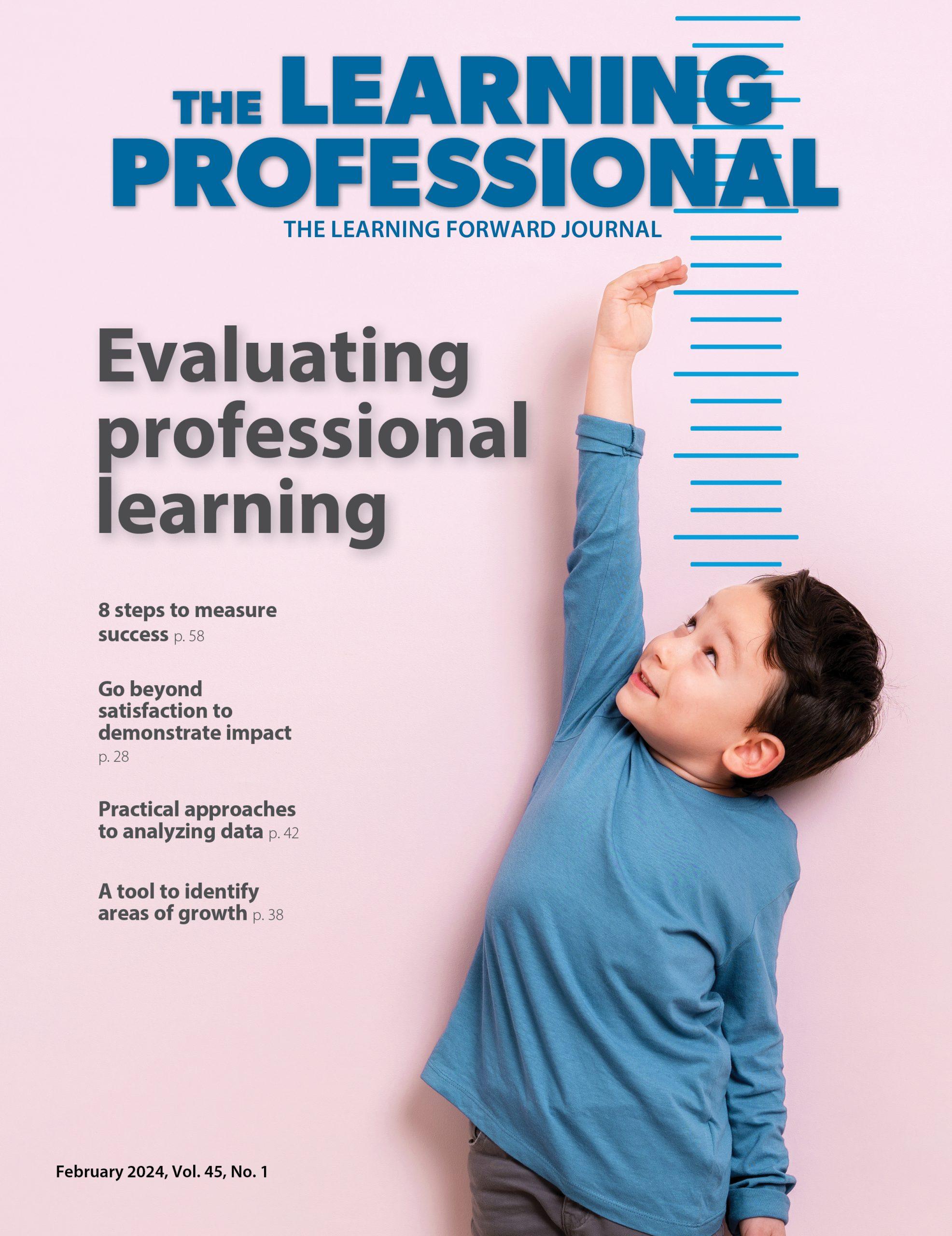IDEAS
A different kind of distance learning
By Suzanne Bouffard
Categories: Coaching, Implementation, Mentoring & induction, Online learning, Personalization, TechnologyAugust 2020
Vol. 41, No. 4
MARCIA ROCK is one of the preeminent researchers on bug-in-ear coaching. In this method, an instructional coach watches a live video feed of a teacher’s classroom and provides in-the-moment feedback via a wireless earpiece. The process, which is sometimes compared to a football coach communicating with a quarterback, is become increasingly feasible and popular thanks to ubiquitous videoconferencing and mobile technology. Rock spoke with The Learning Professional to share insights and advice based on her research.
With bug-in-ear technology, coaching is on the spot, even if the coach isn't. #LearnFwdTLP Share on XQ: How did you start researching bug-in-ear coaching?
A: It came from a real-world need. When I was [a professor] at the University of Alabama, I was working on a grant to help general education teachers become special education teachers. I was scouring the literature looking for how to create a program that would have a real impact on teachers, students, and families.
In particular, I was thinking about how to support teachers to facilitate the transfer of their knowledge into practice. Western Alabama is very rural and spread out — some districts only have one building for all of K-12 — so I knew it would be challenging to provide all the support the teachers needed.
I came across Mary Catherine Scheeler’s work at Penn State. She’s the person who brought bug-in-ear coaching, which had been around for over five decades, into the 21st century. Her focus was on special education. I thought, “How do we do this in a way that bridges with general education? And how do we leverage the technology that we’re using in our daily lives?”
This was around 2007, and we didn’t really have iPhones yet, but I knew there had to be a way to take on-site coaching and do it online so that the coach and the teacher wouldn’t need to be in the same place. I started talking to undergraduates who were gamers about how to do this. They suggested using Skype, which was [relatively new and] not a household name yet. I started testing out the technology with my son, who was in middle school.
Then when I began using it with teachers, I loved it immediately. Using Skype, I could see more than I do when I’m in the classroom. I’m such a teacher at heart that, when I’m in the classroom, it’s hard for me to disconnect myself and be a neutral observer. I have to sit on my hands or it becomes co-teaching [instead of coaching].
But on Skype, I had both an insider’s and an outsider’s view at the same time. I see what’s happening in the moment, but I also see what came before and what might come ahead. It’s a different kind of companioning.
Q: What are the other benefits of bug-in-ear coaching?
A: One of the major benefits is the immediacy of the impact of the coach’s feedback on the teacher and students. I have seen this in my own experience and in the literature. When the teacher tries a strategy in the moment and sees it making a difference, the immediacy of the impact creates positive momentum for the teacher to use the practice again.
One of the major benefits of bug-in-ear coaching is the immediacy of the impact of the coach's feedback on teachers and students. #LearnFwdTLP Share on XWhen you give feedback after the lesson [for example, while watching video with the teacher] and the teacher sets the intention to use the practice in the next lesson, you lose some of that momentum.
But I still advocate for video analysis as part of a continuum of technology-enabled coaching. Sometimes you do need to have space and time in between the feedback and the next lesson to reflect about what the right move was in that situation. Using video strategically and intentionally can be very beneficial.
Neither method should be used alone. Using video on a regular basis is too costly and time-intensive. But it’s also not feasible or sustainable to rely on bug-in-ear as your sole method of coaching. For example, we use 20 to 30 minutes for a video session, rather than the 45 minutes or an hour that is standard with a traditional coaching session.
Q: How do you deal with the discomfort teachers might feel about receiving feedback this way?
A: We always say that we are not big brother and we’re not nagging mother. We are the supportive other. But we know from the literature that anxiety is a major barrier to using this approach. It takes about three sessions for people to become comfortable [with getting feedback from a disembodied voice].
We have found that it’s most helpful in those initial sessions to use a mixture of quietly observing and providing positive feedback. Teachers can get overwhelmed with too much feedback right away, but they also didn’t like it when we tried staying silent in those early sessions.
People often ask if it will be stressful or confusing for teachers to process the coaching and classroom interactions at the same time. But it only takes about five minutes for people to adjust to processing multiple sources of incoming auditory stimuli. You can actually see that moment of adjustment in almost every video we took of teachers using the technology.
But it’s also important to remember that different people grow and develop in different ways. Some people don’t take to it right away. We often found that those people need to find an opportunity to make it their own before using a new strategy. And some of them respond better to other components included in the coaching continuum, like peer feedback.
Q: What should coaches keep in mind when using bug-in-ear coaching?
A: The kind of feedback you provide is important. The rule of thumb is to provide four positive statements to one instructive or corrective one. I also use a lot of “we” language to show we are working together and so it doesn’t sound like I’m saying, “You’re doing it wrong.”
As far as the content of the coaching, the coach and the teacher co-construct the goals. As with in-person coaching, we do a pre- and post- session on either end of the lesson. We consider questions like: What are your strengths and problems of practice? What data are you looking at that’s driving your desire to do things differently? These become the focus areas.
But we also comment on other things we see going on. It’s like when you eat. You don’t just want one thing on your plate at a time, because that’s not nourishing. I don’t suggest things that would be too big of a cognitive load in the moment — for example, asking the teacher to completely change gears to a different type of instruction.
But I do comment on things like lesson structure. I might say, “Wow, you really capitalized on prior knowledge there.” Or I might suggest a tactic, like, “Hmm, we don’t have anyone responding. Let’s try a think-pair-share here.” I address whatever is most needed and will make the biggest difference for students, and that’s often real-world connections and strategies for student engagement.
This is different than some approaches. For example, some bug-in-ear coaching, especially those used for highly prescriptive special education approaches, focuses on very specific pedagogical practices. Coaches using that approach give very specific codes to remind teachers about practices they have learned about previously.
The context in which I have done my research is different. [In the general education classrooms where I have worked], I have used a running commentary approach. We don’t know from the literature whether codes or running commentary is more effective, but they might each be effective in different contexts.
Q: How popular is bug-in-ear coaching?
A: It has grown a lot. It’s being used by at least 12 states in different capacities — for example, in universities, state departments of education, and district alternative certification programs.
We have found it to be very popular with the teachers in our research studies. In interviews we conducted, teachers — who all had previous experience with traditional forms of coaching — told us they wanted everyone to have this experience. They didn’t even mind the fact that many of them encountered bumps with using the technology.
What’s fascinating is how receptive to the bug-in-ear coaching teachers are even when they don’t have previous relationships with us. When I started working with the North Carolina Department of Public Instruction, I was coaching teachers from across the state whom I had never met.
What has emerged from our research is that the driving factor [in whether the coaching succeeds] is the will to grow. Does the teacher want to be better? If they do, our studies suggest that it doesn’t matter how young or old they are, how experienced, or how well you know them.
Q: Are you using bug-in-ear coaching during distance learning?
A: We have not been doing this in real-time online classrooms because we didn’t want to add to everyone’s stress and cognitive load, which is already so high right now [due to the COVID-19 pandemic]. I’m conflicted because I know people need time and space to make adjustments to this situation we’re in. But they also need support, and giving them too much space could make them feel unsupported and anxious.
I think it absolutely could be added as another level of support if you are intentional about it. The key is that you have to think about how the instruction is designed. How are kids engaged in ways that are different than in a physical classroom? How do you do this so it reduces anxiety rather than making it worse?
Can bug-in-ear coaching be used during distance learning? Marcia Rock, one of the preeminent researchers on bug-in-ear coaching, says absolutely. #LearnFwdTLP Share on XI’m continuing work with the North Carolina Department of Public Instruction and also working this summer with the North Carolina new teacher support program on implementing bug-in-ear coaching, along with the other three components included in the technology-enabled continuum, next year, whether it’s in classrooms or in online lessons. So we are considering these questions about what this should look like in online classrooms.
Q: What do you recommend as a first step for educators who want to try bug-in-ear coaching?
A: I recommend finding and connecting with others who are interested in it, either those who are already doing it or who want to start. This way, you’ll have support and someone to help you keep the momentum going when things get tough. Those people don’t have to be in your building. They can be anywhere. They just have to be ready and willing to companion with you on that journey.
Download PDF here.

Suzanne Bouffard is senior vice president of communications and publications at Learning Forward. She is the editor of The Learning Professional, Learning Forward’s flagship publication. She also contributes to the Learning Forward blog and webinars. With a background in child development, she has a passion for making research and best practices accessible to educators, policymakers, and families. She has written for many national publications including The New York Times and the Atlantic, and previously worked as a writer and researcher at the Harvard Graduate School of Education. She has a Ph.D. in developmental psychology from Duke University and a B.A. from Wesleyan University. She loves working with authors to help them develop their ideas and voices for publication.
Categories: Coaching, Implementation, Mentoring & induction, Online learning, Personalization, Technology
Recent Issues
LEARNING TO PIVOT
August 2024
Sometimes new information and situations call for major change. This issue...
GLOBAL PERSPECTIVES
June 2024
What does professional learning look like around the world? This issue...
WHERE TECHNOLOGY CAN TAKE US
April 2024
Technology is both a topic and a tool for professional learning. This...
EVALUATING PROFESSIONAL LEARNING
February 2024
How do you know your professional learning is working? This issue digs...










